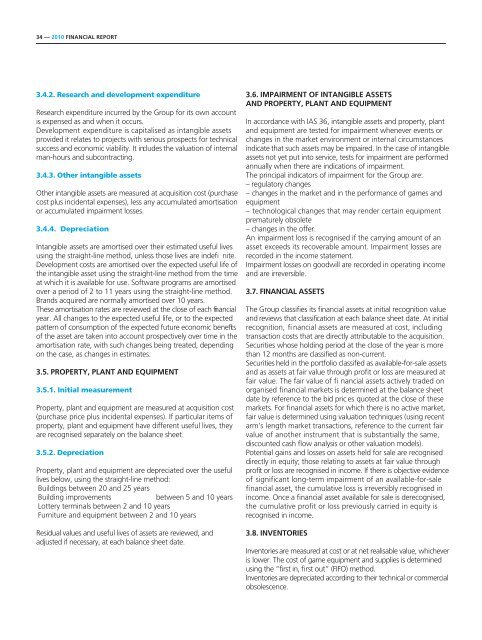You also want an ePaper? Increase the reach of your titles
YUMPU automatically turns print PDFs into web optimized ePapers that Google loves.
34 — 2010 <strong>FINANCIAL</strong> <strong>REPORT</strong><br />
3.4.2. Research and development expenditure<br />
Research expenditure incurred by the Group for its own account<br />
is expensed as and when it occurs.<br />
Development expenditure is capitalised as intangible assets<br />
provided it relates to projects with serious prospects for technical<br />
success and economic viability. It inclu<strong>des</strong> the valuation of internal<br />
man-hours and subcontracting.<br />
3.4.3. Other intangible assets<br />
Other intangible assets are measured at acquisition cost (purchase<br />
cost plus incidental expenses), less any accumulated amortisation<br />
or accumulated impairment losses.<br />
3.4.4. Depreciation<br />
Intangible assets are amortised over their estimated useful lives<br />
using the straight-line method, unless those lives are indefi nite.<br />
Development costs are amortised over the expected useful life of<br />
the intangible asset using the straight-line method from the time<br />
at which it is available for use. Software programs are amortised<br />
over a period of 2 to 11 years using the straight-line method.<br />
Brands acquired are normally amortised over 10 years.<br />
These amortisation rates are reviewed at the close of each fi nancial<br />
year. All changes to the expected useful life, or to the expected<br />
pattern of consumption of the expected future economic benefi ts<br />
of the asset are taken into account prospectively over time in the<br />
amortisation rate, with such changes being treated, depending<br />
on the case, as changes in estimates.<br />
3.5. PROPERTY, PLANT AND EQUIPMENT<br />
3.5.1. Initial measurement<br />
Property, plant and equipment are measured at acquisition cost<br />
(purchase price plus incidental expenses). If particular items of<br />
property, plant and equipment have different useful lives, they<br />
are recognised separately on the balance sheet.<br />
3.5.2. Depreciation<br />
Property, plant and equipment are depreciated over the useful<br />
lives below, using the straight-line method:<br />
Buildings between 20 and 25 years<br />
Building improvements between 5 and 10 years<br />
Lottery terminals between 2 and 10 years<br />
Furniture and equipment between 2 and 10 years<br />
Residual values and useful lives of assets are reviewed, and<br />
adjusted if necessary, at each balance sheet date.<br />
3.6. IMPAIRMENT OF INTANGIBLE ASSETS<br />
AND PROPERTY, PLANT AND EQUIPMENT<br />
In accordance with IAS 36, intangible assets and property, plant<br />
and equipment are tested for impairment whenever events or<br />
changes in the market environment or internal circumstances<br />
indicate that such assets may be impaired. In the case of intangible<br />
assets not yet put into service, tests for impairment are performed<br />
annually when there are indications of impairment.<br />
The principal indicators of impairment for the Group are:<br />
– regulatory changes<br />
– changes in the market and in the performance of games and<br />
equipment<br />
– technological changes that may render certain equipment<br />
prematurely obsolete<br />
– changes in the offer.<br />
An impairment loss is recognised if the carrying amount of an<br />
asset exceeds its recoverable amount. Impairment losses are<br />
recorded in the income statement.<br />
Impairment losses on goodwill are recorded in operating income<br />
and are irreversible.<br />
3.7. <strong>FINANCIAL</strong> ASSETS<br />
The Group classifi es its fi nancial assets at initial recognition value<br />
and reviews that classifi cation at each balance sheet date. At initial<br />
recognition, fi nancial assets are measured at cost, including<br />
transaction costs that are directly attributable to the acquisition.<br />
Securities whose holding period at the close of the year is more<br />
than 12 months are classifi ed as non-current.<br />
Securities held in the portfolio classifi ed as available-for-sale assets<br />
and as assets at fair value through profi t or loss are measured at<br />
fair value. The fair value of fi nancial assets actively traded on<br />
organised fi nancial markets is determined at the balance sheet<br />
date by reference to the bid pric es quoted at the close of these<br />
markets. For fi nancial assets for which there is no active market,<br />
fair value is determined using valuation techniques (using recent<br />
arm’s length market transactions, reference to the current fair<br />
value of another instrument that is substantially the same,<br />
discounted cash fl ow analysis or other valuation models).<br />
Potential gains and losses on assets held for sale are recognised<br />
directly in equity; those relating to assets at fair value through<br />
profi t or loss are recognised in income. If there is objective evidence<br />
of significant long-term impairment of an available-for-sale<br />
fi nancial asset, the cumulative loss is irreversibly recognised in<br />
income. Once a fi nancial asset available for sale is derecognised,<br />
the cumulative profit or loss previously carried in equity is<br />
recognised in income.<br />
3.8. INVENTORIES<br />
Inventories are measured at cost or at net realisable value, whichever<br />
is lower. The cost of game equipment and supplies is determined<br />
using the “fi rst in, fi rst out” (FIFO) method.<br />
Inventories are depreciated according to their technical or commercial<br />
obsolescence.



